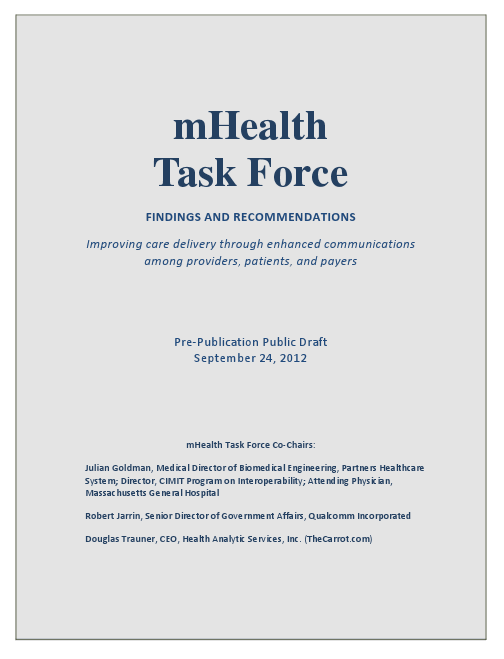
mHealth Task Force Report

mHealth Task Force Report
In June, the FCC (Federal Communications Commission) created a mHealth Task Force from a group of the nation’s leading mobile healthcare IT industry, including government and academic experts, according to a recent press release. This group generated a report with recommendations on mHealth technology use, released on Sept. 24.
The document is written for a federal and regulatory audience more so than the consumer or business-based mobile health IT organization. However, each recommendation will eventually affect the producers and consumers alike of mobile health IT by virtue of federal reform, so it’s important to stay educated and informed in mHealth policy as it evolves.
The first goal that the task force decided on was that the FCC should play a leadership role in advancing mobile health adoption. A few of the main supporting recommendations included:
- Filling the FCC Healthcare Director open position that would serve as the liaison with other federal agencies, including the HHS (Department of Health and Human Services).
- Improve outreach activities to connect with healthcare organizations, including ‘non-traditional constituents’ such as nonprofits, research institutions and small companies that may not be familiar with industry regulations. There is emphasis on providing easy-to-find educational materials via the FCC’s website for the average consumer.
- Which brings us to the recommendation that the FCC should publish a healthcare website – complete with links to other federal healthcare websites, mHealth policies, new projects and more. It should also serve as a clearinghouse for the public and industry. (Check out our health IT and HIPAA resources for articles and tips).
Other recommendations included a push for more collaborative efforts between federal agencies to uniformly regulate and guide the mHealth industry, as well as strive to improve health IT in areas that require it:
- The Secretary of HHS should post a report of health IT strategy and recommendations, including mobile medical applications, on the websites of the FDA, ONC and FCC agencies.
- The FCC and FDA should continue ongoing collaboration to address overlapping issues, such as the efficiency of wireless medical device regulation, and seek public engagement in their efforts related to converged medical devices.
- The FCC and CMS (Center for Medical Services) should exchange and study data on rural healthcare providers that lack broadband connectivity in order to increase outreach to areas that could benefit from programs that could fund mHealth solutions.
- The FCC should use big data to improve health IT by analyzing existing wireless coverage, census, and health data statistics to help rural, suburban and urban populations.
- Even the issue of ‘common nomenclature’ is targeted – the task force claims there is no defined and standard glossary of mHealth terms that are used across the many agencies that oversee health IT. Once developed in collaboration with the FCC, a glossary should be published online for public and agency use.
- Collaboration between the FCC and the ONC should work to provide secure health messaging and communication standards, such as standardizing the adoption of sending authenticated messages and encrypted health information over the Internet.
The task force also calls on the FCC to improve their Rural Health Care Program by providing functionality at the lowest cost. They recommend modernizing the Lifeline program that ensures the availability of broadband service for low-income consumers, a program that helps with healthcare provider-patient care.
Community input is highlighted by the task force as valuable – they recommend the FCC should solicit input from the medical community to figure out how to support the transmission of medical images and video communication. Apparently, healthcare facilities are currently using image disks to import data from thousands of patient-provided image disks on a yearly basis. The call for a national IT infrastructure to support these needs is emphasized.
 One solution that may help with the need for storage-intensive applications and medical imaging data is a high-capacity, HIPAA compliant cloud. With a fully managed SAN (Storage Area Network), a high-capacity cloud is scalable to grow to fit data storage needs. To ensure compliance can be maintained in the cloud, data centers and hosting providers should also undergo an audit to meet HIPAA compliance and sign a business associate agreement. Find out which questions to ask your HIPAA hosting provider in our HIPAA Hosting white paper.
One solution that may help with the need for storage-intensive applications and medical imaging data is a high-capacity, HIPAA compliant cloud. With a fully managed SAN (Storage Area Network), a high-capacity cloud is scalable to grow to fit data storage needs. To ensure compliance can be maintained in the cloud, data centers and hosting providers should also undergo an audit to meet HIPAA compliance and sign a business associate agreement. Find out which questions to ask your HIPAA hosting provider in our HIPAA Hosting white paper.
In step with integrating third-party devices and software solutions, the task force also calls for secure and trusted application interfaces (API’s) for health information exchange and data services in order to solve cost, risk and ongoing maintenance issues that serve as barriers to health IT investments.
The report is a good first pass at documenting what needs to be done just to start managing the industry, but I expect a more polished and detailed mHealth plan to emerge in the near future.








